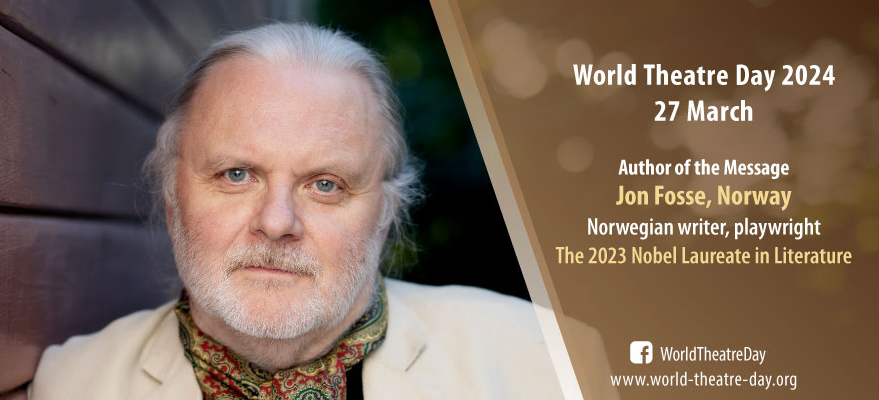
On World Theatre Day
Alsir Alsayed
March 27th of each year is World Theatre Day. This year, in 2024, the Norwegian writer and Nobel Prize laureate of last year (Jon Fosse) penned the World Theatre Day Message, translated into Arabic by the Tunisian theatre artist (Anwar El Shaafi).
The message, which I refer to in its translated Arabic version, titled "Art is Peace", is written in a poetic language charged with emotion, perhaps due to the ideas it conveys. These ideas, generally speaking, are not devoid of proximity to the realms of philosophy or even Sufism, as it is a cognitive achievement known to all peoples. The message, in its entirety, speaks of humanity as a social being, simultaneously in touch with the cosmic, then cast into history to be seen with the rest of humanity, with people. Within the eloquence and philosophy of the message, it uses the term "person" to express humanity, a term that, as we know, carries many cognitive connotations through its manifestations in philosophy, Sufism, society, economy, and culture. The message states, "Every person is unique and at the same time resembles any other person..."
The irony lies here in the combination of uniqueness and resemblance. As much as a person is unique, they resemble another person, whether in nature, genes, or personal experience. However, when we place this uniqueness and resemblance within the framework of history and its societal constructs, people or humans, as much as they are "unique" with their own individuality, they are also "alike" with their commonalities and what unites them.
The message says, "People from all over the world are fundamentally similar no matter what language they speak, the color of their skin, or their hair. This may be paradoxical, that we are exactly alike and completely different at the same time."
The value of this hypothesis, presented in a message and pleading with a poetic style laden with emotion, hovering around the fever of philosophy and Sufism, lies in its, contrary to what is prevailing, as much as it extols (difference), it also extols similarity and commonality. As much as it elevates the value of uniqueness, it also elevates the value of similarity and commonality. Here lies its uniqueness in its endeavor to localize what I call (coexistence), which here does not only mean managing difference as is currently prevalent, but also looking at the presence of similarity and activating it instead of suppressing it with the authority of difference. And perhaps this is what (art) can do or is capable of doing. The message states, "But art, good art, miraculously succeeds in combining the unique and the cosmic..." until it says, "Art can understand cosmically, thus penetrating boundaries and all regions of the world and countries. Thus, it not only combines the characteristics specific to each individual but also, in other words, the individual characteristics shared by groups of people, nations, for example. Art does not make them all identical, but on the contrary, it highlights their differences..."
This entire message is devoted to revealing that as much as we are similar as humans, we are always bothered and frightened by uniqueness and difference, especially when, according to him, "it turns into a collective identity where the different is considered a threat that must be controlled...". Therefore, he sees war as nothing but a struggle against what lies within us, against what is unique. He sees good art always striving "to ensure that what is completely unique becomes, distinctively, cosmically unique" and perhaps this is what led him to conclude his message by saying "War and art are as incompatible as war and peace... Art is peace."
In conclusion of this brief commentary, I say:
(As Sudanese and Sudanese theatre artists, since April 15, 2023, we have been living in a war that has destroyed crops and generations. Its main cause lies in the inability of its instigators or their disregard to recognize the value of uniqueness and difference in its presence with the similar and common, or the value of the similar and common in its presence with uniqueness and difference. Therefore, the majority of our artists have said with loud voices: (No to war)... Stop the war and return to peace. It is a message that perfectly reflects our situation.
Thank you to the great writer (Jon Fosse)
Thank you to the artist (Anwar El Shaafi)
And best wishes to you all).

